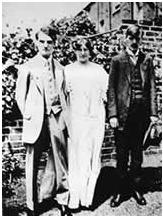A New Life
Around 3 March 1912, visiting his Nottingham Professor Ernest Weekley for advice about the future, he met and fell in love with Weekley's wife Frieda von Richthofen, six years older than himself. The whole direction of his life changed; he broke off for the last time with Jessie Chambers and set himself to earn his living as a professional writer. Frieda was going to Germany in May; he went with her, and worked to persuade her to leave her husband, which meant leaving her three young children too. Not for months was the situation resolved; some of the vicissitudes of this time are recreated in Lawrence's poetry collection Look! We Have Come Through! In Germany, however, Lawrence finished Paul Morel, and worked hard at short stories. He and Frieda ended up sharing a flat in Icking, near München, which belonged to Alfred Weber. Heinemann turned down Paul Morel on grounds of indecency, but Duckworth took it over and Garnett persuaded Lawrence to give it a final revision. After Lawrence and Frieda had travelled down to Italy, walking wherever they could (over the Pfitscher Joch for example), in September they settled in Villa, near Gargnano, beside the Lago di Garda, and Lawrence turned his novel into Sons and Lovers, published the following May. What supported them financially was The Trespasser; and to add to his happiness, during their first months in Italy Frieda finally resolved to stay with him. He was a man exhilarated by the new experience of Italy, by creative achievement, and by love: a very strenuous kind of love. Frieda was 'the one possible woman for me, for I must have opposition – something to fight'; marrying Jessie Chambers 'would have been a fatal step, I should have had too easy a life, nearly everything my own way'. He cooked, cleaned, wrote, argued; Frieda had few housewifely virtues but could always hold her own against his theorising.
During the winter, Lawrence wrote two plays (including his best, The Daughter-in-Law), more poetry (his first volume, Love Poems and Others was published in February 1913), and started a number of new novel projects. He wrote two hundred pages of a book he called The Insurrection of Miss Houghton; but The Sisters – originally 'for the "jeunes filles"' – would determine his course as a novelist for the next three years. Back in Germany by the early summer of 1913, he wrote some of his finest short stories, including that published as 'The Prussian Officer'. Returning to England, with Garnett's help he took care of the publication of short stories new and old (he realised that the new novel project would be a long one); his meeting with Edward Marsh and immediate fellow-feeling with Katherine Mansfield and John Middleton Murry established friendships which would be long and significant.
The period August 1913 to June 1914 saw him revising The Widowing of Mrs. Holroyd (published 1914) and working through many drafts of The Sisters. The novel he ended up with, The Wedding Ring, proved an attractive prospect to publishers who had been impressed by Sons and Lovers; he acquired a three-volume novel contract with Methuen. Back in England and living in London, he and Frieda got married on 13 July 1914. Lawrence also compiled his short story collection The Prussian Officer, and met Catherine Carswell, Richard Aldington and S. S. Koteliansky, all of whom would remain his friends for life.

John Middleton Murry, Frieda and Lawrence on the Lawrences' wedding day (Lawrence Collection)
The Lawrences had intended to return to Italy; but the outbreak of war saw The Wedding Ring returned by Methuen and travel abroad impossible. For the rest of the year they lived in Buckinghamshire, near Murry and Katherine Mansfield, and Lawrence wrote his Study of Thomas Hardy before starting yet another revision of his novel; this time turning its first half into The Rainbow and leaving the rest of the material on one side. Lawrence was now moving in circles centred on Garsington Manor and Lady Ottoline Morrell; he had met (and thoroughly impressed) Bertrand Russell and E. M. Forster, and later befriended Philip Heseltine (Peter Warlock), the young Aldous Huxley and the painters Mark Gertler and Dorothy Brett. In March 1915 he finished The Rainbow: 'Now off and away to find the pots of gold at its feet'. He planned a lecture course with Bertrand Russell and, in the autumn, started a magazine (The Signature) with Murry and Katherine Mansfield. But all these developments came to nothing. The Signature folded; he quarrelled with Russell; Methuen published The Rainbow in September 1915, but it got savage reviews and was withdrawn from sale; at Bow Street Magistrates Court on 13 November it was banned (Lawrence having no opportunity to defend it). Lawrence's career as a writer was dreadfully damaged; he had already thought of going to America to start again there, though at this stage he elected to stay in England. But after The Rainbow disaster he left London to live in Cornwall as a temporary refuge until they could get out of England altogether. The idea of leaving marked the first stage of his disillusionment with what England offered him, and with what he could do for it as a writer.
© Professor John Worthen, 2005
Next chapter: War